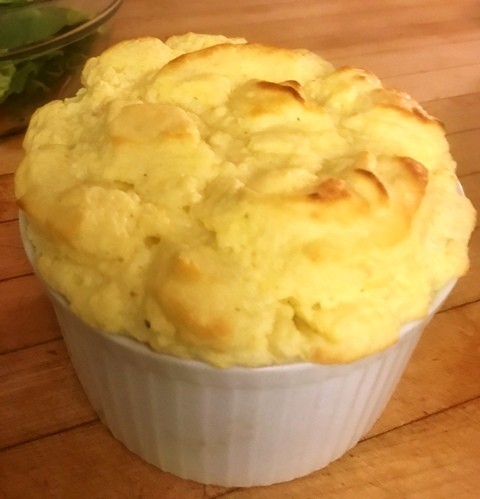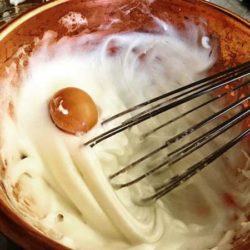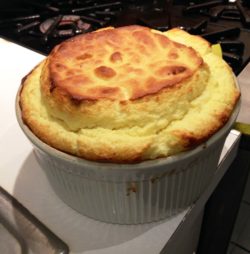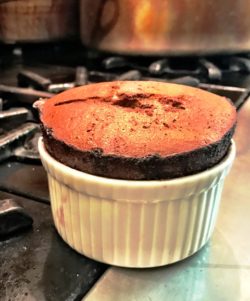Read Time: 6 Minutes Subscribe & Share
You Can Do This
 Do you have eggs, milk, butter in your fridge? Is there salt and pepper on your counter, nutmeg lurking on a shelf, flour, sugar, and chocolate in your cupboard? Maybe some hard cheese and a softer one floating in the crisper drawer? Guess what? You can make a souffle – it really is easy. Besides a functioning oven (always handy), check your drawers for a good heat conducting saucepan, a whisk or electric beater, a metal or glass bowl, a casserole dish, spatula and grater. I’m a great believer in scales, but if you are clinging to your measuring cups and spoons, that is just dandy. Less than 30 minutes of your precious time and another 20-30 minutes in the oven and pouf! you are done. And people will think you’re a genius.
Do you have eggs, milk, butter in your fridge? Is there salt and pepper on your counter, nutmeg lurking on a shelf, flour, sugar, and chocolate in your cupboard? Maybe some hard cheese and a softer one floating in the crisper drawer? Guess what? You can make a souffle – it really is easy. Besides a functioning oven (always handy), check your drawers for a good heat conducting saucepan, a whisk or electric beater, a metal or glass bowl, a casserole dish, spatula and grater. I’m a great believer in scales, but if you are clinging to your measuring cups and spoons, that is just dandy. Less than 30 minutes of your precious time and another 20-30 minutes in the oven and pouf! you are done. And people will think you’re a genius.
Little Things Mean A Lot
Most of the time I beat egg whites in a copper bowl in the belief that 1. it increases my upper  arm strength and 2, the meringue is silkier and does not deflate as easily as it would if done in a mixer. You can turn the bowl upside down or rest a raw egg in the shell on the meringue to check for the right consistency. The egg should barely sink into the egg whites or the meringue should not really plop out of the bowl. If you opt for a mixer, start the speed at a moderately slow tempo and then increase it. You will have a happier meringue. Even adding a pinch of salt can help keep the egg whites from collapsing if that has been an issue for you in previous attempts. Another option with a dessert soufflé is to take some of the sugar specified in the recipe and add it slowly to the whisked whites to help stabilize them.
arm strength and 2, the meringue is silkier and does not deflate as easily as it would if done in a mixer. You can turn the bowl upside down or rest a raw egg in the shell on the meringue to check for the right consistency. The egg should barely sink into the egg whites or the meringue should not really plop out of the bowl. If you opt for a mixer, start the speed at a moderately slow tempo and then increase it. You will have a happier meringue. Even adding a pinch of salt can help keep the egg whites from collapsing if that has been an issue for you in previous attempts. Another option with a dessert soufflé is to take some of the sugar specified in the recipe and add it slowly to the whisked whites to help stabilize them.
I use extra large eggs, which weigh about 65 grams in the shell. I prefer brown eggs, as the yolks are usually a deeper yellow than white eggs.Try to have the whites at room temperature before whisking. Make sure you get all the white out of the shell or your hand. Whites left in the shell can amount to a whole white if you are using 5 to 6 eggs. If you want a creamy souffle, the interior temperature should be around 155F, a bit more solid is around 160F. Thermapens are really handy for this little check.
Tricks Of The Trade
I learned some other interesting pointers from Jacques Pépin, who wrote two marvelous books 42 years ago: La Technique and La Methode. Check with Bonnie Slotnick Cookbooks for hardcover versions. He advised that soufflés can be prepared and placed in their molds one to two hours in advance and kept in the fridge. I agree that you want the soufflé dish to be almost filled, if possible.. In fact, popping your prepped recipe in the fridge will help the soufflé rise straight up instead of over the sides. He advised that at least put your prepped soufflé dish in the fridge while the base and meringue are made. I also take a knife and cut a circle into the soufflé, about an inch in from its border, once it is ready to go into the oven. That way you get that nice inside puff. Sort of a designer detail.
Ceramic makes a better container to bake in than metal, particularly in this case. Your soufflé crust will be softer. And if you use a soufflé dish, the higher side-to-diameter ration produces more dramatic results. You can create your bechamel base or your chocolate base and keep them at room temperature. Cover each with buttered parchment or wax paper to avoid getting a “skin”. Then when you are ready, add the whipped whites at the last minute and pop it in the oven. Next week, I will have a post on why Pillivuyt is my go-to supplier of culinary porcelain.
An Old Recipe And A New One
My all-time favorite cheese soufflé recipe is from the Chamberlain cookbook, The Flavor Of France with a few adjustments I learned from Mary Bond, an American woman who had the courage to persevere at the Cordon Bleu Cooking School in Paris for three years to garner the Grande Diplome. I think she was one of a handful who succeeded at this in the 1950s.
recipe is from the Chamberlain cookbook, The Flavor Of France with a few adjustments I learned from Mary Bond, an American woman who had the courage to persevere at the Cordon Bleu Cooking School in Paris for three years to garner the Grande Diplome. I think she was one of a handful who succeeded at this in the 1950s.
You will be making a cream sauce (or béchamel in French) and then adding an equal amount each of a flavorful semi-soft cheese (gruyere, cheddar, comte are suggestions only) and a hard cheese (parmesan, pecorino, asiago, for example). You should include a bit of grated nutmeg (fresh, please) and some salt and white pepper if you have it. If not, use black – it will give a sharper pepper taste. Once you have incorporated the mixed yolks into your base, you want it to be lukewarm when you add it to the whipped whites. You will use some additional finely grated hard cheese to line the buttered interior of your mold.
This particular chocolate soufflé is an unusual one and creamier than other versions. It is from Christophe Felder, a pastry chef whose wild  recipes I just adore. I think his method of folding the yolks into the meringue and then adding the chocolate base is ingenious. I always butter the souffle dish and then add sugar and cocoa powder to line the interior instead of just sugar. It’s important not to skimp on buttering the mold and make sure that the sugar (or sugar and cocoa powder) thoroughly line the interior. This allows the souffle to hang onto the sides in that first blast of heat.
recipes I just adore. I think his method of folding the yolks into the meringue and then adding the chocolate base is ingenious. I always butter the souffle dish and then add sugar and cocoa powder to line the interior instead of just sugar. It’s important not to skimp on buttering the mold and make sure that the sugar (or sugar and cocoa powder) thoroughly line the interior. This allows the souffle to hang onto the sides in that first blast of heat.
Some More Options
After I learned how to make Setteveli I started using the croquant instead of sugar to line the souffle dish. It just gives the crust a surprising sweet crunch. And once you make the croquant from Setteveli, it keeps for weeks and you can use it in ice creams, a base layer for brownies or as decor on cakes. For Felder’s recipe, it’s specially important to purchase a superior couverture chocolate. My favorites for chocolate souffle are the mid-range (cocoa solids over 60% but under 72%) and I have used Cluizel, Valrhona, Venchi, Slitti and Amedei with great success. A large bowl of whipped cream is de rigueur as you pull your trembling masterpiece out of the oven So here is a recipe developed by Stella Parks of Bravetart fame, available through Epicurious. This way, the whipped cream is done several hours before you start putting this recipe together.


- 4 tbs (57gr) unsalted butter
- 4 tbs (7.8gr) white all purpose flour
- 2 cups (1/2 lt )whole milk
- Pinch each of salt, pepper and fresh grated nutmeg
- 3/4 cup each grated (90gr)Swiss Cheese and (75gr)Parmesan
- 5 extra large eggs, separated
- 1 extra egg white will give you a higher rise (optional)
- Extra parmesan for lining the souffle dishes
- Preheat oven to 400F
- Butter heavily an 8 cup souffle dish or 6 smaller ones for individual servings.
- Shake enough grated parmesan into each so that the interior is fully covered.
- In a good heat-conducting saucepan (I use copper) over medium low heat, melt the butter
- Add the flour and whisk until it is incorporated.
- While whisking, add the milk, your pinches of salt, pepper and nutmeg.
- Stir this mixture for 5 minutes as it must remain smooth (I prefer a wood spoon for this).
- Add the two cheeses and stir mixture until smooth
- Remove from heat and whisk in the five yolks.
- Your base custard should be smooth and off the heat while you whisk 5-6 egg whites until they hold stiff peaks.
- Fold a third of them into your base with a spatula.
- Fold the remaining two thirds lightly.
- Pour into your molds allowing them to be at least 3/4 full.
- Put them on a baking sheet and slide the molds into the 400F oven
- In a few minutes lower the heat to 375F and check after 20 minutes.
- Souflles should be lightly brown on top and the internal temperature around 155-160F
- Serve immediately!
- The eggs I use weigh 65 grams in the shell. A large soufflé mold will take longer than 20 minutes to cook than individual ones.


- 8 oz/ (225gr) 70% chocolate
- 2 2/3oz (75gr) unsalted butter (1/3 cup)
- 9.5oz (270gr) egg whites (1 1/4 cups)
- 3.5oz (90gr) caster sugar (1/2 cup)
- 4 large or extra large egg yolks
- Preheat oven to 420F
- Generously butter an 8 cup soufflé mold or heat-proof tea cups or ramkins
- Sift caster sugar or a combination of caster sugar and cocoa generously in the interior.
- You can also use our Setteveli Croquant to line the molds.
- Melt the chocolate (if it is in block form, cut into shards) in a bowl over simmering water.
- Add the butter and allow it to melt into the chocolate, off the burner.
- Stir the combination and leave at warm room temperature.
- Whip the egg whites and add 25% of the sugar in teaspoons as you are whisking.
- Then you can add the 75% remaining in 3 spoonfuls so that you have a meringue-like finish.
- Whisk the yolks and incorporate them into the meringue.
- Fold the chocolate butter mixture gently into the yolk-enriched meringue.
- Fill your molds about three fourths full.
- Put your molds on a bake sheet and slide them into the oven.
- Individual molds will take 10 to 15 minutes, but a large mold will take 20-25 minutes.
- The souffle should be creamy in the interior and served immediately..
- Christophe Felder suggests that you can add liqueur soaked pieces of savoiardi or ladyfingers in the middle of the souffle before putting it in the oven.

Kitchen Detail shares under the radar recipes, explores the art of cooking, the stories behind food, and the tools that bring it all together, while uncovering the social, political, and environmental truths that shape our culinary world.




[…] soared above the others was Pillivuyt. Not just for clafouti experiments, but also for the soufflé recipes from last week’s post, potato gratins, fruit cobblers and assorted experiments from cooking […]
[…] but just watch the amount of mace used to substitute for nutmeg. It gives a subtle flavor to a cheese souffles, quiches and gnocchi. And it is the secret to some Bolognese ragù recipes. To paraphrase an […]